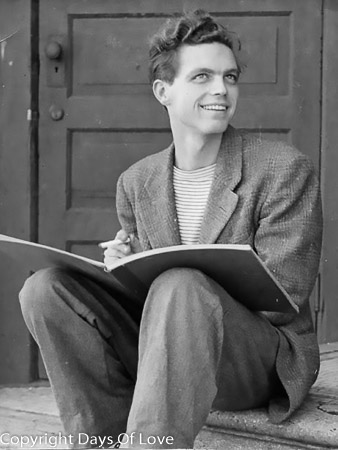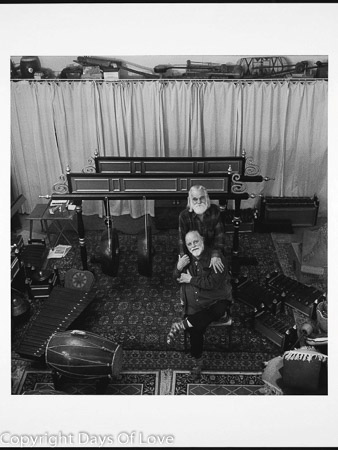

Partner William Colvig
Queer Places:
Burlingame High School, 1 Mangini Way, Burlingame, CA 94010, Stati Uniti
University of California, Los Angeles, Los Angeles, California 90095, Stati Uniti
San Francisco State University, 1600 Holloway Ave, San Francisco, CA 94132, Stati Uniti
Black Mountain College, Black Mountain, NC 28711, Stati Uniti
Harrison House, 6881 Mt Lassen Ave, Joshua Tree, CA 92252, Stati Uniti
 Lou
Silver Harrison (May 14, 1917 – February 2, 2003) was an American composer. He
was a student of Henry Cowell, Arnold Schoenberg, and K. P. H. Notoprojo.
Lou
Silver Harrison (May 14, 1917 – February 2, 2003) was an American composer. He
was a student of Henry Cowell, Arnold Schoenberg, and K. P. H. Notoprojo.
Addressing the post-WWI period in his enormous overview of twentieth-century music, but without the ulterior agenda of the anti-gay conspiracy theorists, Alex Ross writes: Homosexual men, who make up approximately 3 to 5 percent of the general population, have played a disproportionately large role in composition of the last hundred years. Somewhere around half of the major American composers of the twentieth century seem to have been homosexual or bisexual: Aaron Copland, Virgil Thomson, Leonard Bernstein, Samuel Barber, Marc Blitzstein, John Cage, Harry Partch, Henry Cowell, Lou Harrison, Gian Carlo Menotti, David Diamond, and Ned Rorem, among many others.
Harrison is particularly noted for incorporating elements of the music of non-Western cultures into his work, with a number of pieces written for Javanese style gamelan instruments, including ensembles constructed and tuned by Harrison and his partner William Colvig. The majority of his works are written in just intonation rather than the more widespread equal temperament. Harrison is one of the most prominent composers to have worked with microtones.
Harrison was born in Portland, Oregon, but moved with his family to a number of locations around the San Francisco Bay Area as a child. He graduated from Burlingame High School in Burlingame, California in 1934, then he moved to San Francisco.[1] The diverse music which he was to be exposed to there, including Cantonese opera, Native American music, Mexican music, and jazz as well as classical music, was to have a major influence on him. He also heard recordings of Indonesian music early in life.

Photo by
Robert Giard, Rights Notice: Copyright Jonathan G. Silin (jsilin@optonline.net)
Harrison House Retreat
Harrison took Henry Cowell's "Music of the Peoples of the World" course, and also studied counterpoint and composition with him. He later went to the University of California at Los Angeles to work at the dance department as a dancer and accompanist. While there, he took lessons from Arnold Schoenberg which led to an interest in Schoenberg's twelve-tone technique.[2] The pieces he was writing at this time, however, were largely percussive works using unconventional materials, such as car brake drums, as musical instruments. These pieces were similar to those being written by John Cage around the same time, and the two sometimes worked together.
In 1943, Harrison moved to New York City, where he worked as a music critic for the Herald Tribune.[2] While there he met Charles Ives, became his friend, and did a good deal in bringing Ives to the attention of the musical world, which had largely ignored him up to that point. With the assistance of his mentor Cowell, Harrison prepared and conducted the premiere of Ives's Symphony No. 3, and in return received help from Ives financially. When Ives won the Pulitzer Prize for Music for that piece, he gave half of the money to Harrison. Harrison also edited a large number of Ives's works, receiving compensation often in excess of what he billed.[3]
Harrison supported and promoted the music of a number of unconventional composers in addition to Ives. These included Edgard Varèse, Carl Ruggles, and Alan Hovhaness.[4] Later during his time in North Carolina, Harrison taught at Black Mountain College. In 1947, he suffered a nervous breakdown, and moved back to California.
Following in the path of Canadian composer Colin McPhee, who had done extensive research in Indonesian music in the 1930s and wrote a number of compositions incorporating Balinese and Javanese elements, Harrison's style began to change, showing the influence of gamelan music more clearly if only in timbre: "It was the sound itself that attracted me. In New York, when I changed gears out of twelve tonalism, I explored this timbre. The gamelan movements in my Suite for Violin, Piano, and Small Orchestra [1951] are aural imitations of the generalized sounds of gamelan".[5] Virgil Thomson (with whom Harrison also studied) gave him a copy of Harry Partch's book on musical tuning, Genesis of a Music, which prompted Harrison to start writing music in just intonation.[6] He did not abandon equal temperament altogether, but often expressed a desire to do so. In an oft-quoted comment referring to the frequency ratios used in just intonation, he said, "I'd long thought that I would love a time when musicians were numerate as well as literate. I'd love to be a conductor and say, 'Now, cellos, you gave me 10:9 there, please give me a 9:8 instead,' I'd love to get that!"
Although much influenced by Asian music, Harrison did not visit the continent until a 1961 trip to Japan and Korea and a 1962 trip to Taiwan.[7] He and his partner William Colvig later constructed a tuned percussion ensemble, using resonated aluminum keys and tubes, as well as oxygen tanks and other found percussion instruments. They called this "an American gamelan," in order to distinguish it from those in Indonesia. [They also constructed?] gamelan-type instruments tuned to just pentatonic scales from unusual materials such as tin cans and aluminium furniture tubing. He wrote "La Koro Sutro" (in Esperanto)[8] for these instruments and chorus, as well as "Suite for Violin and American Gamelan." In addition, Harrison played and composed for the Chinese guzheng zither, and presented (with Colvig, his student Richard Dee, and the singer Lily Chin) over 300 concerts of traditional Chinese music in the 1960s.[9]
He was a composer-in-residence at San Jose State University in San Jose, California during the 1960s. The university honored him with an all-Harrison concert in Morris Daley Auditorium in 1969, featuring dancers, singers, and musicians. The highlight of the concert was the world premiere of Harrison's depiction of the story of Orpheus, which utilized soloists, the San Jose State University a cappella choir, as well as a unique group of percussionists.
Like many other 20th-century composers, Harrison found it hard to support himself with his music, and took a number of other jobs to earn a living, including record salesman, florist, animal nurse, and forestry firefighter.
Harrison was outspoken about his political views, such as his pacifism (he was an active supporter of the international language Esperanto), and the fact that he was gay. He was also politically active and informed, including knowledge of gay history. He wrote many pieces with political texts or titles, writing, for instance, Homage to Pacifica for the opening of the Berkeley Headquarters of the Pacifica Foundation, and accepting commissions from the Portland Gay Men's Chorus (1988 and 1985) and by the Seattle Men's Chorus to arrange (1987) his Strict Songs, originally for eight baritones, for "a chorus of 120 male singing enthusiasts. Some of them good; some not so good. But the number is so fabulous".[10] Lawrence Mass[11] describes:
Janice Giteck [12] describes Harrison as:
On November 2, 1990, the Brooklyn Philharmonic premiered Harrison's fourth symphony, which he titled Last Symphony. He combined Native American music, ancient music, and Asian music, tying it all together with lush orchestral writing. A special inclusion was a series of Navajo "Coyote Stories." He made a number of revisions to the symphonies before completing a final version in 1995, which was recorded by Barry Jekowsky and the California Symphony for Argo Records at Skywalker Ranch in Nicasio, California in March 1997. The CD also included Harrison's Elegy, to the Memory of Calvin Simmons (a tribute to the former conductor of the Oakland Symphony, who drowned in a boating accident in 1982), excerpts from Solstice, Concerto in Slendro, and Double Music (his collaboration with John Cage).[13]
Harrison and Colvig built two full Javanese-style gamelan, modeled on the instrumentation of Kyai Udan Mas at U.C. Berkeley. One was named Si Betty for the art patron Betty Freeman; the other, built at Mills College, was named Si Darius/Si Madeliene. Harrison taught at Mills College for several years, where one of his students was Jin Hi Kim. He also taught at San Jose State University and Cabrillo College.
Harrison lived for many years with Bill Colvig in Aptos, California. He and Colvig purchased land in Joshua Tree, California, where they designed and built the Harrison House Retreat, a straw bale house.
Harrison died in Lafayette, Indiana, from a heart attack while on his way to a festival of his music at The Ohio State University.
My published books: